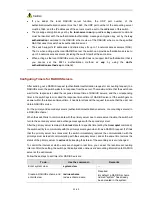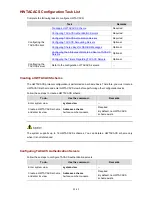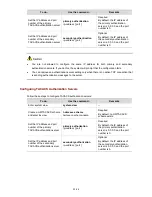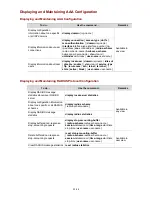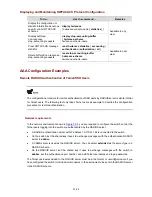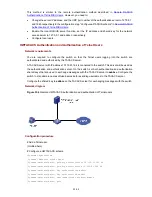
33-20
z
If you adopt the local RADIUS server function, the UDP port number of the
authentication/authorization server must be 1645, the UDP port number of the accounting server
must be 1646, and the IP addresses of the servers must be set to the addresses of this switch.
z
The message encryption key set by the
local-server nas-ip
ip-address key password
command
must be identical with the authentication/authorization message encryption key set by the
key
authentication
command in the RADIUS scheme view of the RADIUS scheme on the specified
NAS that uses this switch as its authentication server.
z
The switch supports IP addresses and shared keys for up to 16 network access servers (NAS).
That is, when acting as the local RADIUS server, the switch can provide authentication service to
up to 16 network access servers (including the switch itself) at the same time.
z
When acting as the local RADIUS server, the switch does not support EAP authentication (that is
you cannot set the 802.1x authentication method as
eap
by using the
dot1x
authentication-method eap
command).
Configuring Timers for RADIUS Servers
After sending out a RADIUS request (authentication/authorization request or accounting request) to a
RADIUS server, the switch waits for a response from the server. The maximum time that the switch can
wait for the response is called the response timeout time of RADIUS servers, and the corresponding
timer in the switch system is called the response timeout timer of RADIUS servers. If the switch gets no
answer within the response timeout time, it needs to retransmit the request to ensure that the user can
obtain RADIUS service.
For the primary and secondary servers (authentication/authorization servers, or accounting servers) in
a RADIUS scheme:
When the switch fails to communicate with the primary server due to some server trouble, the switch will
turn to the secondary server and exchange messages with the secondary server.
After the primary server remains in the
block
state for a specific time (set by the
timer quiet
command),
the switch will try to communicate with the primary server again when it has a RADIUS request. If it finds
that the primary server has recovered, the switch immediately restores the communication with the
primary server instead of communicating with the secondary server, and at the same time restores the
status of the primary server to
active
while keeping the status of the secondary server unchanged.
To control the interval at which users are charged in real time, you can set the real-time accounting
interval. After the setting, the switch periodically sends online users' accounting information to RADIUS
server at the set interval.
Follow these steps to set timers for RADIUS servers:
To do…
Use the command…
Remarks
Enter system view
—
system-view
Required
Create a RADIUS scheme and
enter its view
radius scheme
radius-scheme-name
By default, a RADIUS scheme
named "system" has already
been created in the system.















